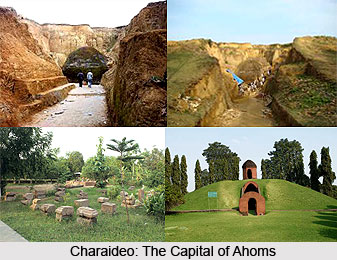 Suklamphaa, also known as Ramdhwaj Singha ruled over the Ahom kingdom from 1772 to 1774 AD. During his reign Debera Borbarua, the minister of the kingdom, extended his powers which was also followed by the struggle for power among the other officials of the kingdom. Quick changes occurred in succession of kings and internal conflicts greatly prevailed in the kingdom.
Suklamphaa, also known as Ramdhwaj Singha ruled over the Ahom kingdom from 1772 to 1774 AD. During his reign Debera Borbarua, the minister of the kingdom, extended his powers which was also followed by the struggle for power among the other officials of the kingdom. Quick changes occurred in succession of kings and internal conflicts greatly prevailed in the kingdom.
Coronation of Suklamphaa
Suklamphaa was Namrupia Raja`s third son, Sureng Deo Raja`s grandson and Suhungmung`s, another Ahom kingdom, great grandson. The former name of Suklamphaa was Sarugohain. His elder brothers, Chakradhwaj Singha and Udayaditya Singha, also succeeded the throne and became the rulers of Ahom kingdom. Suklamphaa succeeded the throne in November 1672 AD. He firstly adopted a Hindu name Ramdhwaj Singha but the Tai-Ahom priest insisted him to take the name of Suklamphaa.
Rise of Debera Borbarua
Debera Hazarika was the leader of the group who were involved in the execution of the new king`s elder brother Udayaditya Singha, who was immensely dissatisfied with the new king and demanded the post of Borbarua. Suklamphaa however had already assigned someone else to the position and thus Debera Hazarika conspired against the king to achieve his demand. In a visit to Charaideo, he informed the king that his younger brother, who was the present Charing Raja and Langichang Borgohain, had possessed the palace of Garhgaon. Debera Hazarika also provided certain false evidences to prove his allegations true. Owing to this, without any formal trial both Langichang Borgohain and Charing Raja were executed. Afterwards, Debera Hazarika also blamed the Borbarua for being involved in the previous conspiracy and made him dismissed from the office by the king. Thus Debera Hazarika achieved his aim of becoming a Borbarua.
Expeditions of Suklamphaa
In Sadiya, the hill tribes of Mishmis and Abors along with the Deori Sutiyas revolted against the authority of the Ahom king. This started during Udayaditya Singha`s rule and turned to be serious affair during the reign of Suklamphaa. To counteract this rebellion Debera Borbarua was sent in an expedition by Suklamphaa and consequently the rebels were gravely defeated.
Atrocities of Debera Borbarua
Suklamphaa fell ill in the year in 1674 AD due to an attack of dropsy. During this time Debera Borbarua arranged expert physicians for the treatment of the king and the prominent officers of the kingdom including Laluk Sola Borphukan and Atan Burhagohain were positioned at Guwahati to defend the probable attack of Mughals from Bengal. Consequently Debera Borbarua got full authority of the capital of Ahom kingdom. By the time the king`s illness became severe, arrangements were made for peaceful succession of the throne in case of sudden demise of the king. The obvious descendents of Suklamphaa were visualized as threat by Debera Borbarua and thus he summoned the nobles who were in favour of this succession in a chamber and killed all of them in one night. The next day he explained the king that they were the enemies of Suklamphaa and thus he executed them.
The brutal actions of Debera Borbarua gradually became intolerable to Suklamphaa and he ordered Tangachu Phukan to finish off Debera Borbarua. As a reward he promised the Phukan to elevate him to the position of Borphukan. However, one of the palace maids informed Debera Borbarua about this plan and the maid received gifts as a reward of this intelligence. When Tangasu Phukan arrived at him his home to kill him, Debera counterattacked him with his sword and killed him. He also asked his officers to kill all the officers of the kingdom who stood against him which led to a massacre of the officers at Garhgaon.
Death of Suklamphaa
When Debera Borbarua observed the king`s recovery, he conspired against him and manipulated the physician to mix poison with his medicine. In November 1674, just three days after the massacre of the officers took place at Garhgaon, Suklamphaa died owing to poisoning. The chief queen of Suklamphaa who used to alert him against the misdeeds of Debera Borbarua was buried along with body of her husband.



















